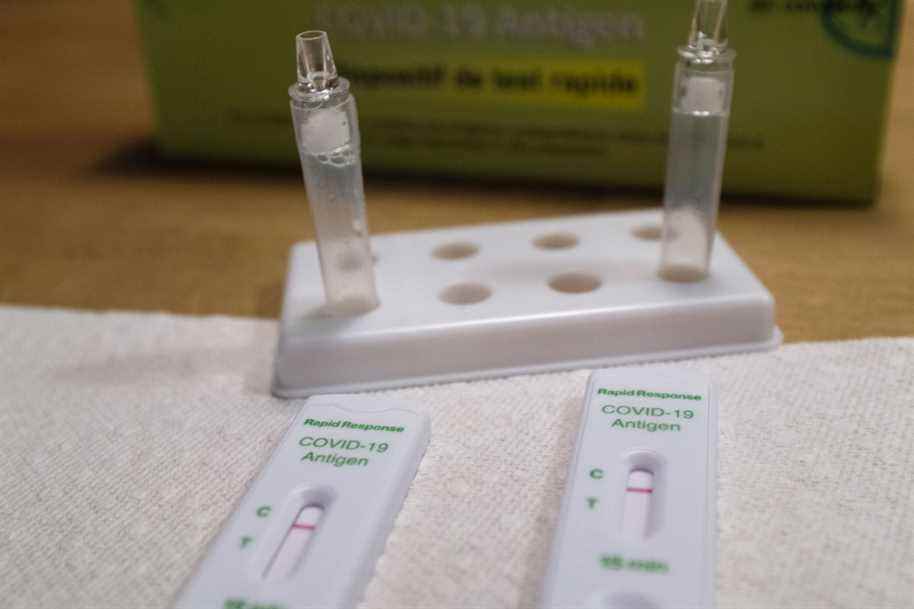(Ottawa) Canada is postponing 11 shipments of rapid test aircraft that were to be delivered via Russian cargo planes.
Posted at 3:39 p.m.
Updated at 9:17 p.m.
A Russian cargo plane successfully delivered a test shipment to Canada on Sunday morning at Toronto’s Pearson International Airport.
A few hours later, Transport Minister Omar Alghabra announced that Canada was closing its airspace to all Russian aircraft, effective immediately, in response to Russia’s unprovoked invasion of Ukraine, and that that plane will remain grounded in Toronto.
Eleven more rapid test shipments were due to be delivered this month on Russian planes, but have all been cancelled.
A spokesman for Public Services and Supply Minister Filomena Tassi said most of the shipments had already found new planes. However, Russian planes can usually carry more cargo and a small number of deliveries have yet to find a place on a cargo plane that can land in Canada.
Since 1er January, 300 million rapid tests were delivered to the federal government, which buys them mainly on behalf of provincial governments.
Legislation to approve $2.5 billion in funding for Health Canada to purchase and distribute the tests received royal assent on Friday. This was in addition to the 1.7 billion approved in the fall budget update, also for rapid testing.
Immunity to Omicron high
Canada’s Chief Public Health Officer, Dr.D Theresa Tam, said during her weekly briefing on Friday that easier access to rapid tests will help Canada in the event of a new wave of COVID-19.

BLAIR GABLE PHOTO, REUTERS ARCHIVES
The Chief Public Health Officer of Canada, D.D Theresa Tam
At the start of the Omicron wave, access to rapid tests became a huge problem as infection rates soared and public health systems could not meet the demand for in-person PCR tests.
This demand has now dropped along with infection rates, and Mme Tam said after months of high infection rates from Omicron and heavy vaccination in Canada, there are high levels of immunity to the variant across the country.
Due to testing limitations, there are not yet good data on how many people have been infected with Omicron, she said. Since Omicron became the dominant variant in Canada in mid-December, 1.3 million cases have been confirmed, but only a small fraction of infections are now recorded.
Ontario’s Chief Medical Officer of Health, Dr.r Kieran Moore said this week that the actual number in his province was likely 10 times the reported figure.
“I think if it’s Omicron that’s circulating next month, we have a very good level of protection in the community, especially with the booster doses protecting against serious consequences,” explained Dr.D Tam. But if there is a very different variant of Omicron, then that’s a different story and we’ll have to reassess the risk of any variants escaping the vaccine. »
The DD Tam said that even if such a variant does arrive, there are more treatment options for COVID-19, including Pfizer’s recently approved antiviral drug Paxlovid, as well as better access to rapid tests, better understanding of transmission of the virus, the benefits of good ventilation and easy access to masks.
She said that with all these measures “we need to be able to go into the fall and winter season, or even the next wave if it were to come in, with a lot more capacity to react without really severe restrictions. That’s the point. »
She urged health systems to take the time they have now to invest so that if another wave arrives, there is no need to resort to drastic closures to prevent hospitals from being overwhelmed.
She said the possibility of reconsidering the way we allow foreign health professionals to work in Canada could come into play, as could the search for efficiency by using virtual care.
Wearing a mask recommended
Mme Tam says face masks should be kept on as the first line of defense against COVID-19 even though they’re not mandatory.

PHOTO ROBERT SKINNER, LA PRESSE ARCHIVES
Alberta and Saskatchewan lifted mask-wearing requirements this week, with Manitoba expected to follow in the middle of the month, Ontario possibly at the end of the month and Quebec in mid-April.
The DD Tam will personally review local infection rates and the risk to her or her family members to determine when or if she will stop wearing a mask.
Infection rates continued to fall this week, as did hospitalizations and the number of people in intensive care.
The number of hospitalized patients with COVID-19 peaked on January 22 at 11,022, including 1,233 in intensive care. As of February 28, there were 5,136 people in hospital and 570 in intensive care. That’s down more than 15% in the last week alone.
Mme Tam said people can help avoid another severe wave by getting vaccinated. Data from the Public Health Agency of Canada shows that since vaccines became available in Canada, unvaccinated and partially vaccinated people accounted for 58% of all cases and 75% of all hospitalizations.
